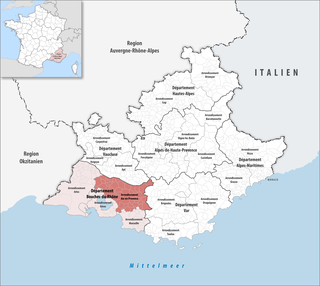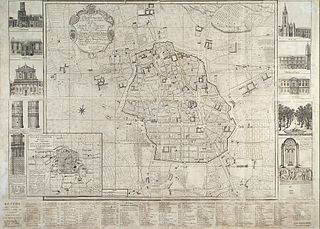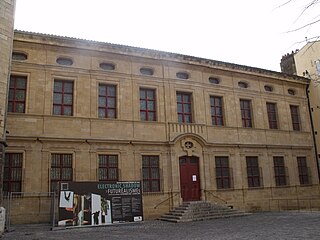

Zola Dam is a dam in Le Tholonet near Aix-en-Provence, France. [1]


Zola Dam is a dam in Le Tholonet near Aix-en-Provence, France. [1]
The dam was designed by Italian-born engineer François Zola, the father of novelist Émile Zola. [1] [2] Its construction was initially rejected by Gaston Alexandre Auguste, Marquis de Galliffet, the landowner, in 1838. [1]
Zola founded the Société du Canal Zola in 1846 and began construction. [2] He died, however, in 1847, and the company was acquired by author and politician Jules Migeon in 1853. [2] Construction of the dam was completed on September 10, 1854, and it was dedicated on December 16, 1854. [2]
The dam was painted by Paul Cézanne in the 1880s. [3] The painting belonged to Paul Gauguin in 1885. It was purchased by Gwendoline Davies in 1918, who donated it to the National Museum Wales in 1952. [3]

Paul Cézanne was a French artist and Post-Impressionist painter whose work laid the foundations of the transition from the 19th-century conception of artistic endeavor to a new and radically different world of art in the 20th century.

Aix-en-Provence, or simply Aix, is a city and commune in Southern France, about 30 km (19 mi) north of Marseille. A former capital of Provence, it is the subprefecture of the arrondissement of Aix-en-Provence, in the department of Bouches-du-Rhône, in the region of Provence-Alpes-Côte d'Azur. The population of Aix-en-Provence is of approximately 143,000. Its inhabitants are called Aixois or, less commonly, Aquisextains.

The Cours Mirabeau is a wide thoroughfare in Aix-en-Provence, France.

The arrondissement of Aix-en-Provence is an arrondissement of France in the Bouches-du-Rhône department in the Provence-Alpes-Côte d'Azur region. It has 48 communes. Its population is 450,153 (2016), and its area is 1,657.5 km2 (640.0 sq mi).

Le Tholonet is a commune in the Bouches-du-Rhône department in southern France. Its inhabitants are called Tholonétiens.

Luynes is a village of the Bouches-du-Rhône département in southern France. It is located 4 km south of Aix-en-Provence at the intersection of the D7 and N8 roads. The village is perhaps best known for its prison and for its three international schools. The Nécropole Nationale de Luynes is also located nearby.

The quartier Mazarin is a district in the centre of Aix-en-Provence, directly to the south of the cours Mirabeau, the principal boulevard in Aix. On the initiative of Archbishop Michel Mazarin, brother of the Cardinal Jules Mazarin and Archbishop of Aix from 1645-8 and later himself a cardinal, city plans were devised in 1646 by Jean Lombard, director of public works, to extend the city ramparts to the south, incorporating land owned by the Archbishopric of Aix and by the Order of Saint-Jean-de-Malte. Following a grid plan of streets, the quartier contains a large number of hôtels particuliers originally built for the nobility and wealthy merchant class.

The Musée Granet is a museum in the quartier Mazarin, Aix-en-Provence, France devoted to painting, sculpture and archeology. In 2011, the museum received 177,598 visitors.

The Église de la Madeleine is a Roman Catholic church in Aix-en-Provence.

The Hôtel de Gantès is a listed hôtel particulier in Aix-en-Provence. Built in 1660, it was home to a private members' club until the French Revolution of 1789, when two aristocratic members were murdered by revolutionaries. Since the 1840s, it has been home to the world-famous café, Les Deux Garçons, a haunt of artists, writers and celebrities.

The Hôtel de Caumont is a listed hôtel particulier in Aix-en-Provence.
The Saint-Pierre Cemetery is a cemetery in Aix-en-Provence. It is home to the burials of many renowned painters and sculptors.
Antoine Aude (1799–1870) was a French lawyer and politician. He served as the Mayor of Aix-en-Provence from 1835 to 1848.

The Hôtel Raousset-Boulbon is a listed hôtel particulier in Aix-en-Provence.

The Fontaine de la Rotonde is a historic fountain in Aix-en-Provence, Bouches-du-Rhône, France.

The Aix-Marseille-Provence Metropolis is the métropole, an intercommunal structure, centred on the cities of Marseille and Aix-en-Provence. It is located in the Bouches-du-Rhône, Var and Vaucluse departments, in the Provence-Alpes-Côte d'Azur region, southeastern France. It was created in January 2016, replacing the previous Communauté urbaine Marseille Provence Métropole and five communautés d'agglomération. Its population was 1,886,842 in 2014, of which 866,644 in Marseille proper and 145,763 in Aix-en-Provence.
The following is a timeline of the history of the city of Aix-en-Provence.

François Zola was an Italian-born French engineer. He built the Zola Dam creating Lac Zola near Le Tholonet in Aix-en-Provence.

Jules Migeon (1815–1868) was a French author, businessman and politician. He served in the Corps législatif from 1852 to 1859.

The Château du Tholonet is an historic château or bastide in Le Tholonet near Aix-en-Provence, France.
| Wikimedia Commons has media related to Barrage de Zola . |
Coordinates: 43°31′56″N5°30′41″E / 43.5323°N 5.5114°E
| | This Bouches-du-Rhône geographical article is a stub. You can help Wikipedia by expanding it. |
| This article about a dam, floodgate or canal in Europe is a stub. You can help Wikipedia by expanding it. |